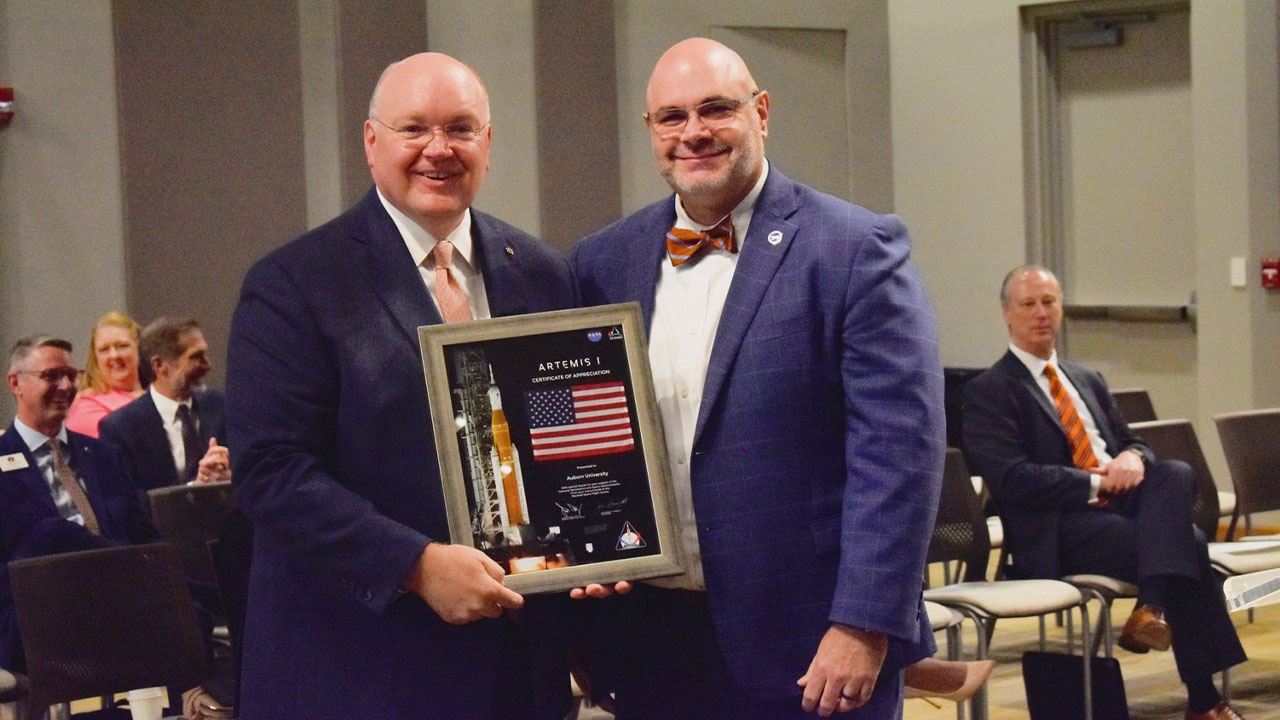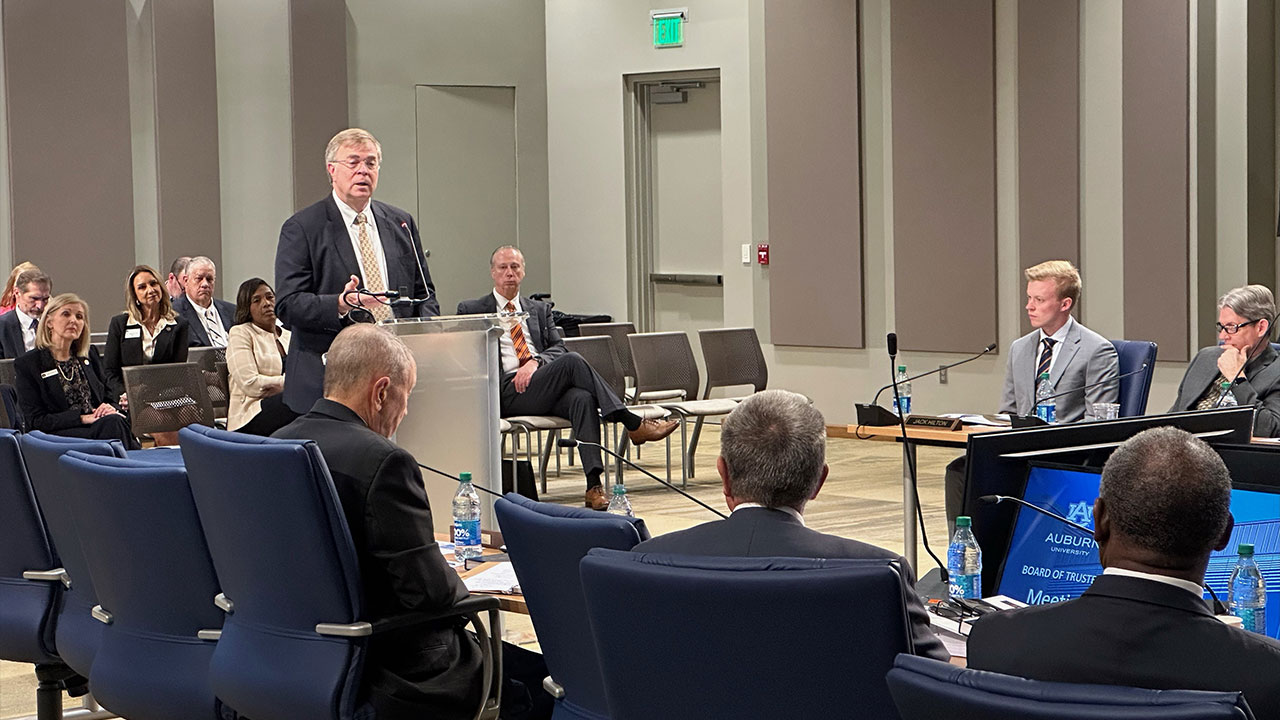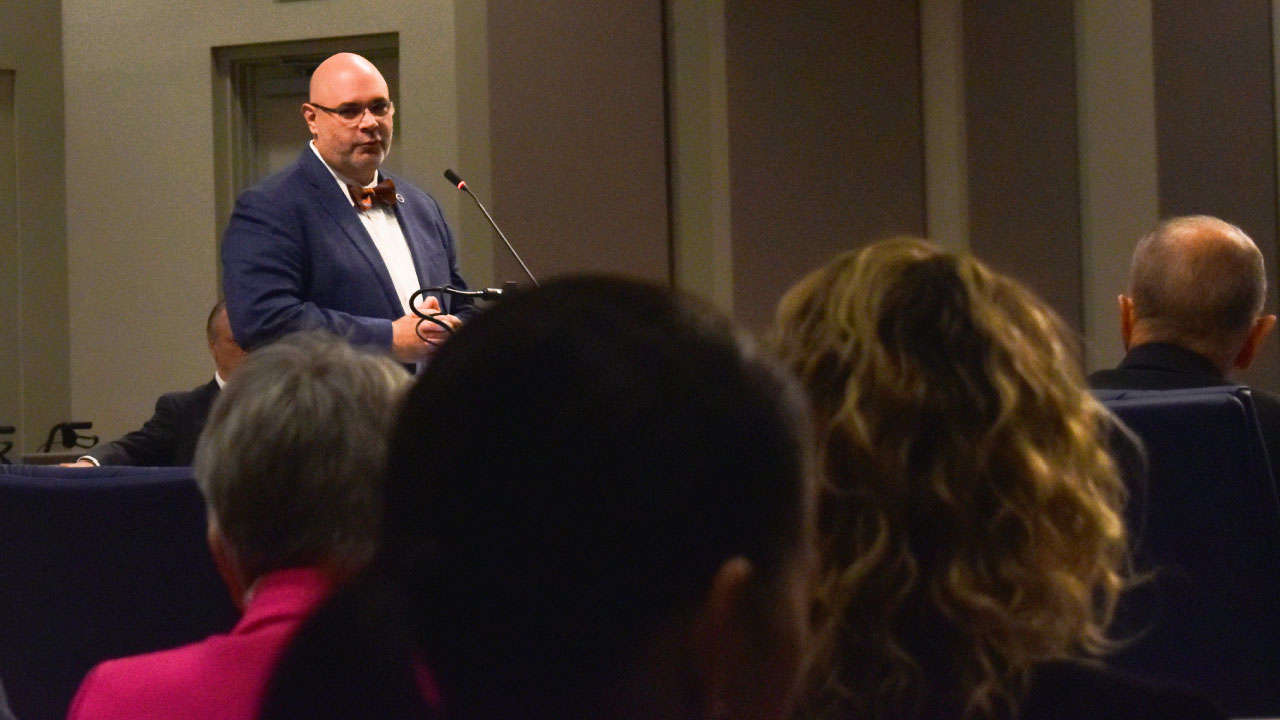content body

Auburn President Christopher B. Roberts accepted a special recognition from Joseph Pelfrey, the new director of NASA's Marshall Space Flight Center in Huntsville. The frame includes a flag that went up in Artemis I.
HUNTSVILLE, Ala. — Auburn University’s presence and impact in the Rocket City are ever-present and on the rise. This point was underscored at the April 12 meeting of the university’s Board of Trustees at the Auburn University Research and Innovation Campus.
In 2022, Auburn moved into the former LogiCore location in Huntsville’s Cummings Research Park. The decision to take over an existing building on nine acres in Alabama’s largest city puts Auburn faculty and researchers at the front door of numerous defense and aerospace collaborators, including Redstone Arsenal, fostering a new era of interagency and interdisciplinary collaboration.
The Auburn University Research and Innovation Campus is a state-of-the-art, multi-million-dollar collaboration engine, conference center and research space that extends Auburn’s expertise and next-generation resources to the defense, space and law enforcement agencies.
Huntsville Mayor Tommy Battle and Auburn President Christopher B. Roberts noted that Auburn’s relationship with the Rocket City stretches back to the birth of the Marshall Space Flight Center in 1960. Brooks Moore, a 1948 Auburn electrical engineering alumnus, was a charter member of the center. He passed away earlier this week at the age of 97.
Battle said that the Auburn University Research and Innovation Campus is not only located in the country’s second largest research park, but in a city “run by engineers, many of which are Auburn alumni.”
“Auburn has been a part of our success forever and ever,” he said, crediting many alumni, including Moore and Trustee Mike DeMaioribus, the former executive vice president from Dynetics Inc. in Huntsville.
“This city is built on knowledge and innovation, and that’s what you [Auburn University] bring to the table,” Battle added.
Joseph Pelfrey, the new director of NASA’s Marshall Space Flight Center, talked about being from a small town and the first in his family to earn a four-year college degree. He praised Auburn faculty and staff for their support and dedication.
“They saw my capacity for success, even if it didn’t reflect in my test scores. And that is Auburn,” he said.
As NASA and Marshall have high aspirations for missions to the moon and Mars, Pelfrey said, “Auburn men and women are working every day to enable those goals.”
Roberts accepted a token of appreciation from Pelfrey, a framed flag that was flown on Artemis I.
Auburn’s research mission
Research at Auburn is big business, and it requires activity throughout Alabama and beyond. Auburn’s research expenditures have doubled since 2013, and in the last five years, new extramural awards have exceeded $1.2 billion.
Recently, Auburn secured the largest research contract in university history — $50 million — to help the U.S. Army Combat Capabilities Development Command Aviation & Missile Center boost its increasing modernization efforts. The project will be facilitated through the Auburn University Applied Research Institute (AUARI), located in the Auburn University Research and Innovation Campus in Huntsville, and rely extensively on research expertise from Auburn’s National Center for Additive Manufacturing Excellence (NCAME) and the Interdisciplinary Center for Advanced Manufacturing Systems (ICAMS).
Just this week, the university announced a new partnership with the Space Development Agency to provide logistical and technical support at Redstone Arsenal. A U.S. Space Force flag now flies in front of the Auburn University Research and Innovation Campus.
Homegrown talent
More than 3,000 current Auburn undergraduate and graduate students are from the Tennessee Valley region of Alabama, with the majority from Madison and Limestone counties. Nearly 30% of these students are studying engineering.
More than 18,000 Auburn alumni call the Tennessee Valley home. Nearly 30% earned degrees from the Samuel Ginn College of Engineering, with top degree choices in electrical, mechanical and aerospace engineering.
The largest employers of these Auburn alumni include Dynetics, Huntsville Hospital, Boeing, Teledyne-Brown Engineering, Adtran, Hexagon Safety and Infrastructure, NASA and Huntsville City Schools.
Notably, NASA’s Marshall Space Flight Center recently named Joseph Pelfrey its director. Pelfrey earned a bachelor’s degree in aerospace engineering from Auburn in 2000. Fellow Auburn alumnus, Todd May, ’90 materials engineering, previously served as the center’s director from 2016-18.
Explore Auburn discovery at work.
At Auburn, we never stop asking questions to solve real-world problems.
Investigate moreGrowing Alabama’s agricultural economy
Agriculture is a key economic driver for the region and the state, and a major focus of Auburn’s land-grant mission. With the support of five full-time Tennessee Valley Research and Extension Center (TVREC) staff, Auburn researchers and Extension specialists actively conduct more than 55 agricultural experiments a year aimed at helping farmers enhance productivity and practices, while also improving profitability.
In an effort to help farmers realize more profitable pastures, Auburn researchers are exploring the use of feed by-products to reduce pasture fertilization costs while improving beef cattle growth and health, helping to increase farmer profitability. Alabama beef cattle production represents $500 million in annual farm gate receipts.
Other Auburn researchers and Extension specialists are working with farmers at TVREC to explore optimal barley varieties to support Alabama’s 40-plus craft breweries and the state’s craft brew economy, while others are evaluating regional performance and enhanced profitability of a shorter corn variety that requires less water and nutrients and is more tolerant to wind and environmental pressures.
Partnerships
Auburn Outreach engages Tennessee Valley partners, communities, businesses, schools and governments to help citizens meet their educational goals and improve their quality of life.
More than 200 people participate annually in regional continuing education and economic development programs. Nearly 1,000 students from under-resourced Tennessee Valley communities have improved access to post-secondary education through the GEAR UP Achieve initiative.
Full-time faculty from Auburn’s Harrison College of Pharmacy are affiliated with the University of Alabama Family Medicine program in Huntsville, providing clinical care for more than 100 inpatients per week in the Huntsville Hospital and more than 30 patients per week in outpatient clinics.
In the Auburn University Research and Innovation Campus, experimentation with co-located laboratories will allow Auburn research professionals and students to conduct cutting-edge research and development across a range of technology readiness levels to help customers overcome national security, aerospace and biotechnology challenges.
These laboratories will facilitate expansion in Huntsville of high-profile Auburn research programs, such as advanced manufacturing, additive manufacturing, biotechnology, quantum metrology, cyber and critical infrastructure security and assured position, navigation and timing.
To elevate Auburn’s ability to conduct space research, facilities are available for use as an operations center for NASA, the Department of Defense and private sector missions.
Inside the Auburn University Research and Innovation Campus
Auburn’s Applied Research Institute (AUARI) operates within the Research and Innovation Campus, providing 40,000 square feet of laboratory space for Auburn faculty and students to conduct cutting-edge research and development across a range of technology readiness levels to help customers overcome national security, aerospace and biotechnology challenges.
Last fall, Auburn announced a partnership between AUARI and Huntsville energy consultants, Trideum Corporation, for the AUARI to facilitate a $1.1 million award supporting the U.S. Army Redstone Test Center’s Mission Based — Multi Domain Operations Test Environment.
As part of the 18-month project, a team comprised of AUARI engineers, as well as graduate students and faculty members from Auburn’s Department of Electrical and Computer Engineering, will use Model Based Systems Engineering, artificial intelligence and machine learning to help the Redstone Test Center better support Army operational and developmental testing.
In addition to the research and technical aspects, the Research and Innovation Campus showcases rotating exhibits from the university’s Jule Collins Smith Museum of Fine Art and original works by famed artist Gamaliel Rodríguez.
Through the end of the year, the campus will also feature portraits of Auburn’s astronaut alumni — Jan Davis, Hank Hartsfield, Ken Mattingly, Kathryn Thornton, Jim Voss and Clifton Curtis Williams — before they return to Auburn.
Thornton and Hartsfield are alumni of the College of Sciences and Mathematics, while the others are graduates of the Samuel Ginn College of Engineering.
In other matters, the board:
- Granted final approval to the project to renovate a portion of the Recreation and Wellness Center basement, allowing for Health Promotion and Wellness Services to relocate from the Melton Student Center. The renovations will provide new staff offices, collaboration and meeting rooms, as well as personal training and student workspaces. The $3.2 million cost will be financed by Campus Recreation funds.
- Selected Seay, Seay and Litchfield Architects of Montgomery, Alabama, as the architect for the new dormitory project at the Solon Dixon Forestry Education Center in Andalusia. The project will replace two, 1979-era dormitories with a new, more modern facility for students and visitors.
- Took steps on a project to expand the existing terminal ramp at the Auburn University Regional Airport. The growth in the number of aircraft visiting the airport necessitates the expansion, which will add 8,760 square yards of ramp space and provide 15 additional aircraft tie-down spaces. The proposal includes three bid alternates so that more work can be done if favorable bids are received. The estimated cost of $1.6 to $2 million will be financed by the Federal Aviation Administration, Alabama Department of Transportation Aeronautics Bureau and local governments.
- Initiated a plan to purchase a 904.16-acre site in Autauga County for the Alabama Agricultural Experiment Station (AAES). The proposed site has a particular soil type and climate that is desirable for research and is representative of high-producing row crop agriculture in central Alabama. The purchase would be funded by selling unused AAES properties.
- Accepted a plan to purchase a research facility in the City of Auburn’s Technology Park North. The one-story structure on two acres was originally built in 2008 as a manufacturing facility and later upgraded to include significant clean room capabilities to enable research and development and manufacture of pharmaceuticals. Given the current growth of the university’s research program, the purchase of the property would address an immediate need for specialized research space.
- Accepted proposals to dissolve the doctoral program in public administration and public policy — jointly administered by Auburn and Auburn University at Montgomery (AUM) — allowing the program to continue at Auburn, and discontinuing it at AUM, where enrollment has been low.
- Posthumously awarded a Bachelor of Science in business administration in finance to Austin G. Collett and a Master of Science in management information systems to Sujith Babu Gunturu. Both students at AUM passed away before completing the requirements to complete their respective degrees.
- Welcomed Walt Woltosz to his first meeting as a trustee. The Alabama Senate confirmed the two-time Auburn alumnus last month to serve a seven-year term on the board.
- Acknowledged Dan King, who attended his last board meeting as he is retiring next month from his role as associate vice president of Facilities Management.
Additionally, the board learned about:
- A new graduate certificate in health care simulation, offered by the College of Nursing for nurses and nursing students focused on the essential components of simulation as a teaching strategy for health care educators.
- The deletion of program options — equine science and meat science — in the College of Agriculture for the Bachelor of Science in animal science and renaming the remaining options of animal and allied industries as animal industries, and pre-veterinary as pre-veterinary and animal biosciences.
- The deletion of program options — production, soil, water and land use and science — in the Bachelor of Science in crop and soil sciences in the College of Agriculture.






